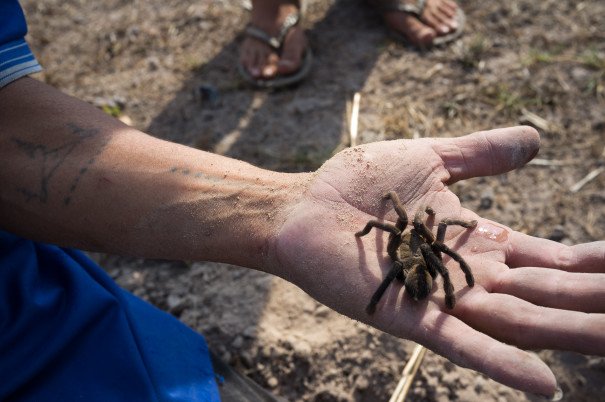
When Breakfast Has Eight Legs

When Breakfast Has Eight Legs
Eating tarantulas in Phumi Khna
Beads of sweat roll down the man’s lean torso, their paths interrupted by a scar decades old. Jam Wai used to hunt the Khmer Rouge, but these days he lives a quiet life in a bamboo hut along Cambodia’s Route 67. In the past few years, he even picked up a new trade. His prey now has eight legs, or six. They are tarantulas and scorpions, and he sells them to restaurants and streetside vendors who serve them as food.
Jam Wai’s gear is minimal: a trowel attached to a wooden pole, its edge sharpened; a bamboo cage, carried by his son, who joins him on hunts; a twig, snapped off from any nearby tree; his bare hands.
The May heat scorches the fallow rice fields, and the rains are late. Tarantulas and scorpions burrow beneath loose dirt to escape the heat until dusk falls. Jam Wai sends his children ahead to scout for nests. It doesn’t take long before our trek brings us to the first few.
He examines a mound, determines that there is, in fact, something below. He raises his trowel-staff, aiming the sharp edge at his concealed prey. He has a couple feet of dirt to get through. A few hard strokes remove earth, then he slows down to dig with precision. Going too deep too quickly would only damage the prize.
He kneels to continue digging with his bare hands. The tarantula, sensing an opening to escape this new threat, makes a run for it, but Jam Wai already has it pinned down with the twig.
He picks it up, grabs his trowel, and presses the tarantula’s head against the bladed end. A slow, hard press shaves off the arachnid’s fangs, which Jam Wai tosses into the brush. Its only means of defense removed, the tarantula cowers in Jam Wai’s palm. Venom pools in his weathered flesh. There’s enough to kill two or three people. The spider shrinks. It’s in pain and fear.
Some say Cambodians eat insects because the Khmer Rouge devastated the country in the mid-1970s, causing widespread famine, and foraging insects for food was the only way to survive. But the fact is that various insects—crickets, silkworms, water bugs, scorpions, tarantulas, and more—have been part of Khmer cuisine for generations. Red ants almost taste like cumin, and are used to flavor beef. Black beetles and locusts are fried and served with garlic. Termite eggs are cooked into salty, sour soup.
Normally, a day of hunting, with help, can yield over 100 spiders and scorpions. But Jam Wai is aware of the dangers of over-hunting. From December to February, he takes a break to let the bugs regrow their population. During that period, he works on a dragonfruit farm to supplement his income.
We continue the trek, and Jam Wai gathers a few more tarantulas, called a-ping in Khmer, as well as a handful of scorpions, their stingers sliced off in the same manner. When we return to his hut, the bugs are dunked into a basin of well water and cleaned. Then they are seasoned and lowered into a pool of cooking oil heated over coals. Sliced garlic sends pleasant smells through the woods nearby.
Jam Wai enjoys the trade. One of his clients is Bugs Cafe, a hip restaurant in Siem Reap that combines the traditional use of insects in Khmer cooking with French and other recipes. The restaurant’s chef, Seiha Soeun, accompanies us, and explains how he himself was a little apprehensive about cooking bugs at first. But once he tried a few dishes—bug burgers, tarantula tempura, stir-fried silkworms—he became hooked.
Breakfast is served. Scorpions are bitter but tarantulas are fleshy and kind of taste like chicken. They’re all great. I stick a few more in my mouth, tossing aside only the pincers.